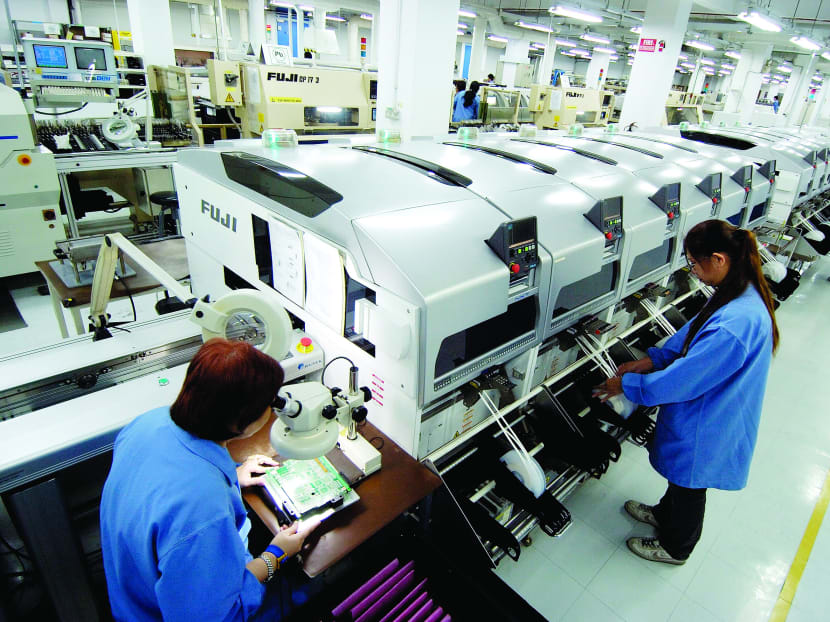Manufacturing activity shrank in April — but at a slower pace
SINGAPORE — Manufacturing activity in Singapore shrank for the 10th consecutive month in April, but the pace of contraction slowed on the back of an improved electronics sector.

The key electronics sub-index shrank for the 10th straight month, but marked a slower rate of contraction. Photo: Bloomberg
SINGAPORE — Manufacturing activity in Singapore shrank for the 10th consecutive month in April, but the pace of contraction slowed on the back of an improved electronics sector.
The Purchasing Managers’ Index (PMI) rose 0.4 points from the previous month to 49.8 points last month, but stayed below the 50-point threshold that separates expansion from contraction, said the Singapore Institute of Purchasing and Materials Management (SIPMM) on Tuesday (May 3).
Despite the improvement, the outlook remains uncertain with the factory sector in China — Singapore’s largest trading partner — remaining in the doldrums.
Almost all the sub-indexes in the Singapore PMI reflected improvements even as they stayed in contractionary territory. A slower rate of contraction was recorded for new orders, new export orders, employment and production. On the other hand, a slower rate of expansion was recorded for inventory, stocks of finished goods and supplier deliveries.
The key electronics sub-index shrank for the 10th straight month but marked a slower rate of contraction at 49.5 points last month compared to the 49 points in March. New orders, new export orders, production, prices and employment registered improvements.
“(The results) reinforce the latest business expectations survey which found a net plus 1 per cent of manufacturers expect more favourable conditions for April to September (up from minus 22 per cent a quarter ago). In particular, the electronics industry appears to have turned the corner with a plus 9 per cent reading versus minus 32 per cent previously, especially for semi-conductor and other electronic modules and components, and precision engineering industries,” said Ms Selena Ling, head of treasury research and strategy at OCBC.
However, the leading indicator could falter again, following last year’s pattern, warned DBS senior economist Irvin Seah.
“Watch out for a PMI head fake ... The same phenomenon occurred in the same period last year. After the Lunar New Year period, manufacturing PMI ventured briefly into the expansion territory in May and June before eventually slipping back into contraction again from July onwards ... So, it remains to be seen whether history will repeat itself again. Chances of a sustained improvement in the PMIs is not high judging from the outlook in the global economy,” said Mr Seah.
Signs that the economic slowdown in China may be levelling off provided some comfort but manufacturing activity in Asia’s largest economy remains a concern.
“We can’t solely attribute the improvement to China as the growth seen in the Chinese state is coming from its services sector, and not the manufacturing sector which is still on a down-trend. It is providing little boost to Singapore,” said UOB economist Francis Tan.
The private sector Caixin/Markit Chinese manufacturing PMI, which focuses on small and medium-sized firms fell to 49.4 last month from 49.7 in March. The official Chinese PMI, which mostly covers larger state-owned manufacturers, came in at 50.1 points in April from 50.2 points in March.
Regional PMIs were a mixed bag. Last month, the PMI for Indonesia continued in expansionary mode and South Korea’s PMI rebounded into expansion. Meanwhile, Malaysia’s PMI contracted further.
Singapore’s manufacturing sector could see a recovery by the second half of this year, but economists said that there would be little to cheer due to the low base effect.
“We expect the sector to rebound in the second half of this year, but it would be due to a low base effect last year. We should not be too overjoyed as the sector is still weak,” Mr Tan said.
“I still don’t see any key drivers bringing the sector to recovery. The European Union is still quite stuck while the United States is picking up but their import growth is not strong and not giving us a boost,” he warned.






